Voet D., Voet Ju.G. Biochemistry
Подождите немного. Документ загружается.

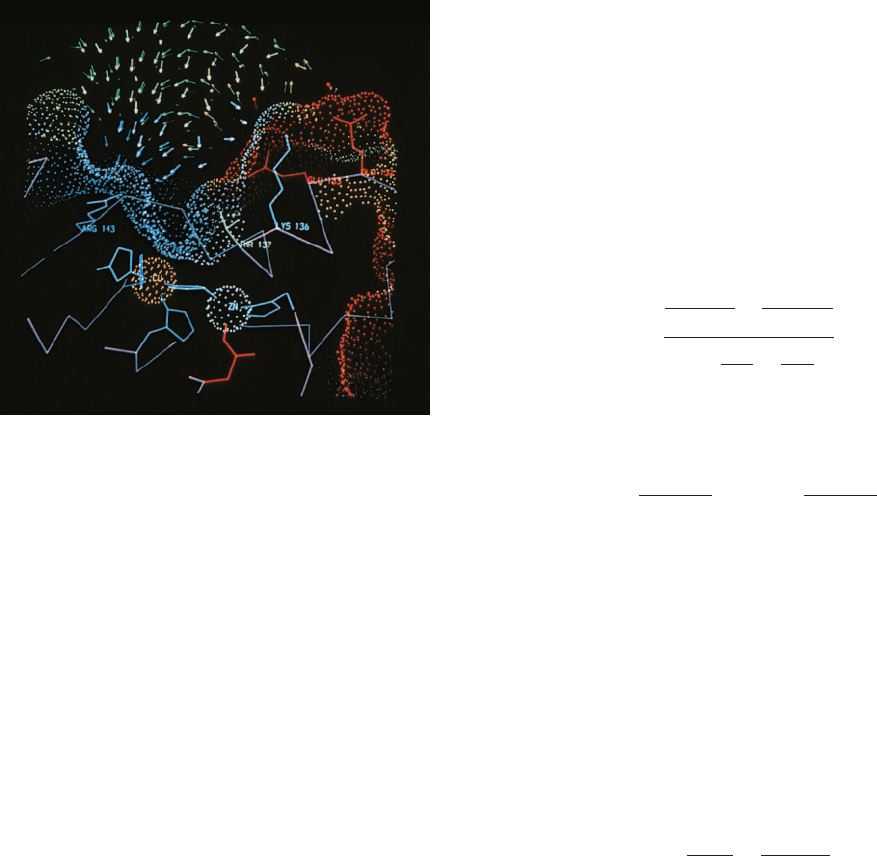
Since the active site of an enzyme generally occupies
only a small fraction of its total surface area, how can any
enzyme catalyze a reaction every time it encounters a sub-
strate molecule? In the case of superoxide dismutase
(SOD), it appears that the arrangement of charged groups
on the enzyme’s surface serves to electrostatically guide
the charged substrate to the enzyme’s active site (Fig. 14-10).
[SOD, which is present in nearly all cells, functions to
inactivate the highly reactive and therefore destructive
superoxide radical by catalyzing the reaction
; Section 22-4Ch]. Other
enzymes, including acetylcholinesterase (Section 20-5C),
have similar mechanisms to funnel polar substrates to their
active sites.
C. Reversible Reactions
The Michaelis–Menten model implicitly assumes that en-
zymatic reverse reactions may be neglected. Yet many en-
zymatic reactions are highly reversible (have a small free
energy of reaction) and therefore have products that back
react to form substrates at a significant rate. In this section
we therefore relax the Michaelis–Menten restriction of no
back reaction and, by doing so, discover some interesting
and important kinetic principles.
2 O
2
ⴢ
⫺
⫹ 2H
⫹
S H
2
O
2
⫹ O
2
O
2
ⴢ
⫺
a. The One-Intermediate Model
Modification of the Michaelis–Menten model to incor-
porate a back reaction yields the following reaction
scheme:
(Here ES might just as well be called EP because this
model does not specify the nature of the intermediate com-
plex.) The equation describing the kinetic behavior of this
model, which is derived in Appendix A of this chapter, is
expressed
[14.30]
where
and
This is essentially a Michaelis–Menten equation that works
backwards as well as forwards. Indeed, at [P] ⫽ 0, that is,
when v ⫽ v
o
, this equation becomes the Michaelis–Menten
equation.
b. The Haldane Relationship
At equilibrium (which occurs after the reaction has run
its course), v ⫽ 0, so Eq. [14.30], which holds at equilibrium
as well as at steady state, can be solved to yield
[14.31]
where [P]
eq
and [S]
eq
are the concentrations of P and S at
equilibrium. This so-called Haldane relationship demon-
strates that the kinetic parameters of a reversible enzymati-
cally catalyzed reaction are not independent of one another.
Rather, they are related by the equilibrium constant for the
overall reaction, which, of course,is independent of the pres-
ence of the enzyme.
c. Kinetic Data Cannot Unambiguously Establish a
Reaction Mechanism
An enzyme that forms a reversible complex with its sub-
strate should likewise form one with its product; that is, it
should have a mechanism such as
The equation describing the kinetic behavior of this two-
intermediate model, whose derivation is analogous to that
described in Appendix A for the one-intermediate model,
E ⫹ S Δ
k
1
k
⫺1
ES Δ
k
2
k
⫺2
EP Δ
k
3
k
⫺3
P ⫹ E
K
eq
⫽
[P]
eq
[S]
eq
⫽
V
f
max
K
P
M
V
r
max
K
S
M
[E]
T
⫽ [E] ⫹ [ES]
K
S
M
⫽
k
⫺1
⫹ k
2
k
1
K
P
M
⫽
k
⫺1
⫹ k
2
k
⫺2
V
f
max
⫽ k
2
[E]
T
V
r
max
⫽ k
⫺1
[E]
T
v ⫽
V
f
max
[S]
K
S
M
⫺
V
r
max
[P]
K
P
M
1 ⫹
[S]
K
S
M
⫹
[P]
K
P
M
E ⫹ S Δ
k
1
k
⫺1
ES Δ
k
2
k
⫺2
P ⫹ E
Section 14-2. Enzyme Kinetics 491
Figure 14-10 Cross section through the active site of human
superoxide dismutase (SOD). The enzyme binds both a Cu
2⫹
and
a Zn
2⫹
ion (orange and cyan spheres). SOD’s molecular surface is
represented by a dot surface that is colored according to its
electrostatic charge, with red most negative, yellow negative,
green neutral, cyan positive, and blue most positive.The
electrostatic field vectors are represented by similarly colored
arrows. Note how this electrostatic field would draw the
negatively charged superoxide ion into its binding site, which is
located between the Cu
2⫹
ion and Arg 143. [Courtesy of Elizabeth
Getzoff, The Scripps Research Institute, La Jolla, California.]
JWCL281_c14_482-505.qxd 6/3/10 12:17 PM Page 491
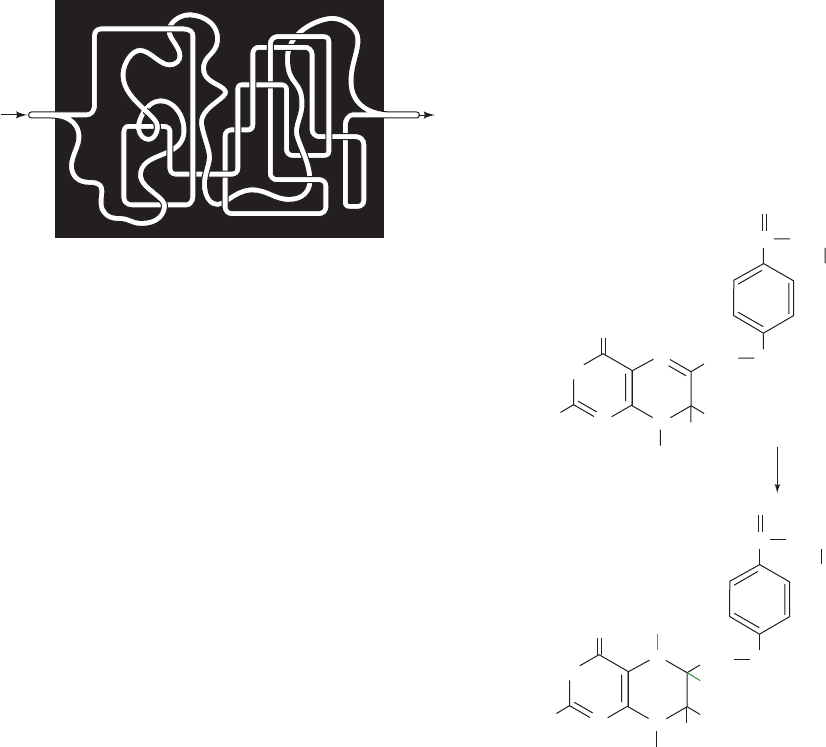
has a form identical to that of Eq. [14.30]. However, its pa-
rameters , , , and are defined in terms of the
six kinetic constants of the two-intermediate model rather
than the four of the one-intermediate model. In fact, the
steady-state rate equations for reversible reactions with
three or more intermediates also have this same form but
with yet different definitions of the four parameters.
The values of , , , and in Eq. [14.30] can
be determined by suitable manipulations of the initial sub-
strate and product concentrations under steady-state con-
ditions. This, however, will not yield the values of the rate
constants for our two-intermediate model because there
are six such constants and only four equations describing
their relationships. Moreover, steady-state kinetic meas-
urements are incapable of distinguishing the number of in-
termediates in a reversible enzymatic reaction because the
form of Eq. [14.30] does not change with the number of
intermediates.
The functional identities of the equations describing
these reaction schemes may be understood in terms of an
analogy between our n-intermediate reversible reaction
model and a “black box” containing a system of water
pipes with one inlet and one drain:
At steady state, that is, after the pipes have filled with wa-
ter, one can measure the relationship between input pres-
sure and output flow. However, such measurements yield
no information concerning the detailed construction of the
plumbing connecting the inlet to the drain. This would re-
quire additional observations such as opening the black
box and tracing the pipes. Likewise, steady-state kinetic
measurements can provide a phenomenological description
of enzymatic behavior, but the nature of the intermediates
remains indeterminate. Rather, these intermediates must be
detected and characterized by independent means such as by
spectroscopic analysis.
The foregoing discussion brings to light a central princi-
ple of kinetic analysis: The steady-state kinetic analysis of a
reaction cannot unambiguously establish its mechanism.
This is because no matter how simple, elegant, or rational a
mechanism one postulates that fully accounts for kinetic
data, there are an infinite number of alternative mecha-
nisms, perhaps complicated, awkward, and seemingly irra-
tional, that can account for these kinetic data equally well.
Usually it is the simpler and more elegant mechanism that
turns out to be correct, but this is not always the case. If,
OutIn
"Black box"
K
P
M
K
S
M
V
r
max
V
f
max
K
P
M
K
S
M
V
r
max
V
f
max
however, kinetic data are not compatible with a given mech-
anism, then the mechanism must be rejected. Therefore, al-
though kinetics cannot be used to establish a mechanism
unambiguously without confirming data, such as the physi-
cal demonstration of an intermediate’s existence, the
steady-state kinetic analysis of a reaction is of great value
because it can be used to eliminate proposed mechanisms.
3 INHIBITION
Many substances alter the activity of an enzyme by com-
bining with it in a way that influences the binding of sub-
strate and/or its turnover number. Substances that reduce
an enzyme’s activity in this way are known as inhibitors.
Many inhibitors are substances that structurally resem-
ble their enzyme’s substrate but either do not react or react
very slowly compared to substrate. Such inhibitors are
commonly used to probe the chemical and conformational
nature of a substrate-binding site as part of an effort to elu-
cidate the enzyme’s catalytic mechanism.In addition, many
enzyme inhibitors are effective chemotherapeutic agents,
since an “unnatural” substrate analog can block the action
of a specific enzyme. For example, methotrexate (also
called amethopterin) chemically resembles dihydrofolate.
Methotrexate binds tightly to the enzyme dihydrofolate re-
ductase, thereby preventing it from carrying out its normal
function, the reduction of dihydrofolate to tetrahydrofo-
late, an essential cofactor in the biosynthesis of the DNA
precursor dTMP (Section 28-3Bd):
N
N
HN
N
H
H
H
O
O
H
2
N
CH
2
NHCHCH
2
CH
2
COO
–
NH
COO
–
C
Dihydrofolate
N
N
HN
N
H
H
H
H
O
O
H
2
N
CH
2
NHCHCH
2
CH
2
COO
–
NH
H
COO
–
C
Tetrahydrofolate
dihydrofolate reductase
492 Chapter 14. Rates of Enzymatic Reactions
JWCL281_c14_482-505.qxd 6/3/10 12:18 PM Page 492
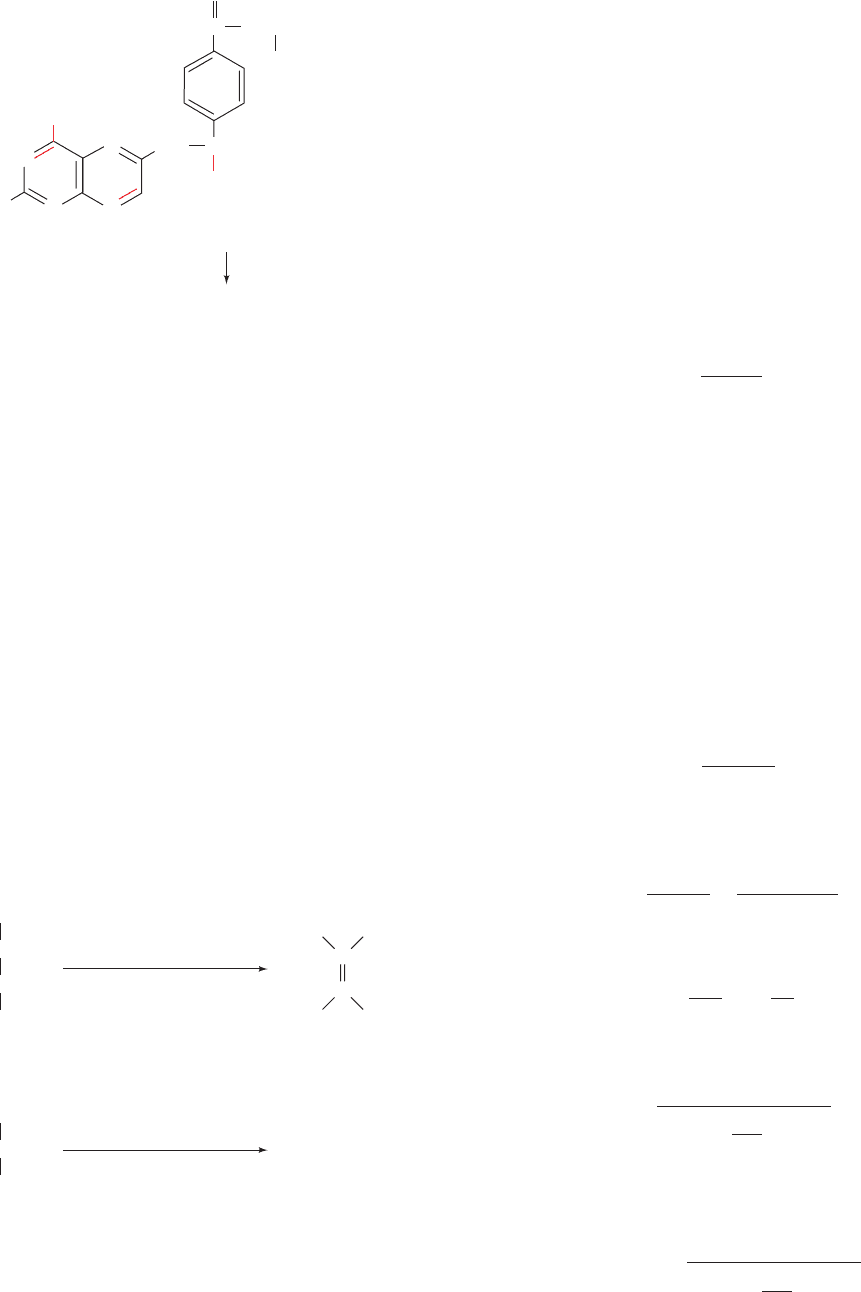
Rapidly dividing cells, such as cancer cells, which are ac-
tively engaged in DNA synthesis, are far more susceptible
to methotrexate than are slower growing cells such as those
of most normal mammalian tissues. Hence, methotrexate,
when administered in proper dosage, kills cancer cells with-
out fatally poisoning the host.
There are various mechanisms through which enzyme
inhibitors can act. In this section, we discuss several of the
simplest such mechanisms and their effects on the kinetic
behavior of enzymes that follow the Michaelis–Menten
model.
A. Competitive Inhibition
A substance that competes directly with a normal substrate
for an enzymatic binding site is known as a competitive in-
hibitor. Such an inhibitor usually resembles the substrate
to the extent that it specifically binds to the active site but
differs from it so as to be unreactive. Thus methotrexate is
a competitive inhibitor of dihydrofolate reductase. Simi-
larly, succinate dehydrogenase, a citric acid cycle enzyme
that functions to convert succinate to fumarate (Section
21-3F), is competitively inhibited by malonate, which struc-
turally resembles succinate but cannot be dehydrogenated:
The effectiveness of malonate in competitively inhibiting
succinate dehydrogenase strongly suggests that the en-
zyme’s substrate-binding site is designed to bind both of
Malonate
COO
–
CH
2
NO REACTION
COO
–
succinate dehydrogenase
Succinate
COO
–
CH
2
CH
2
COO
–
Fumarate
succinate dehydrogenase
–
OOC H
C
C
COO
–
H
N
N
N
N
NH
2
O
H
2
N
CH
2
CH
3
NHCHCH
2
CH
2
COO
–
NH
COO
–
C
Methotrexate
dihydrofolate reductase
NO REACTION
the substrate’s carboxylate groups, presumably through the
influence of two appropriately placed positively charged
residues.
The general model for competitive inhibition is given by
the following reaction scheme:
Here it is assumed that I, the inhibitor, binds reversibly to
the enzyme and is in rapid equilibrium with it so that
[14.32]
and EI, the enzyme–inhibitor complex, is catalytically inac-
tive. A competitive inhibitor therefore acts by reducing the
concentration of free enzyme available for substrate binding.
Our goal, as before, is to express v
o
in terms of measura-
ble quantities, in this case [E]
T
, [S], and [I]. We begin, as in
the derivation of the Michaelis–Menten equation, with the
expression for the conservation condition, which must now
take into account the existence of EI.
[14.33]
The enzyme concentration can be expressed in terms of
[ES] by rearranging Eq. [14.17] under the steady-state
condition:
[14.34]
That of the enzyme–inhibitor complex is found by rear-
ranging Eq. [14.32] and substituting Eq. [14.34] into it:
[14.35]
Substituting the latter two results into Eq. [14.33] yields
which can be solved for [ES] by rearranging it to
so that, according to Eq. [14.22], the initial velocity is
expressed
[14.36]v
o
⫽ k
2
[ES] ⫽
k
2
[E]
T
[S]
K
M
a1 ⫹
[I]
K
I
b⫹ [S]
[ES] ⫽
[E]
T
[S]
K
M
a1 ⫹
[I]
K
I
b⫹ [S]
[E]
T
⫽ [ES] e
K
M
[S]
a1 ⫹
I
K
1
b⫹ 1 f
[EI] ⫽
[E][I]
K
I
⫽
K
M
[ES][I]
[S]K
I
[E] ⫽
K
M
[ES]
[S]
[E]
T
⫽ [E] ⫹ [EI] ⫹ [ES]
K
I
⫽
[E][I]
[EI]
EI ⫹ S
¡
NO REACTION
Δ
K
I
I
⫹
E ⫹ S Δ
k
1
k
⫺1
ES
¡
k
2
P ⫹ E
Section 14-3. Inhibition 493
JWCL281_c14_482-505.qxd 6/3/10 12:09 PM Page 493
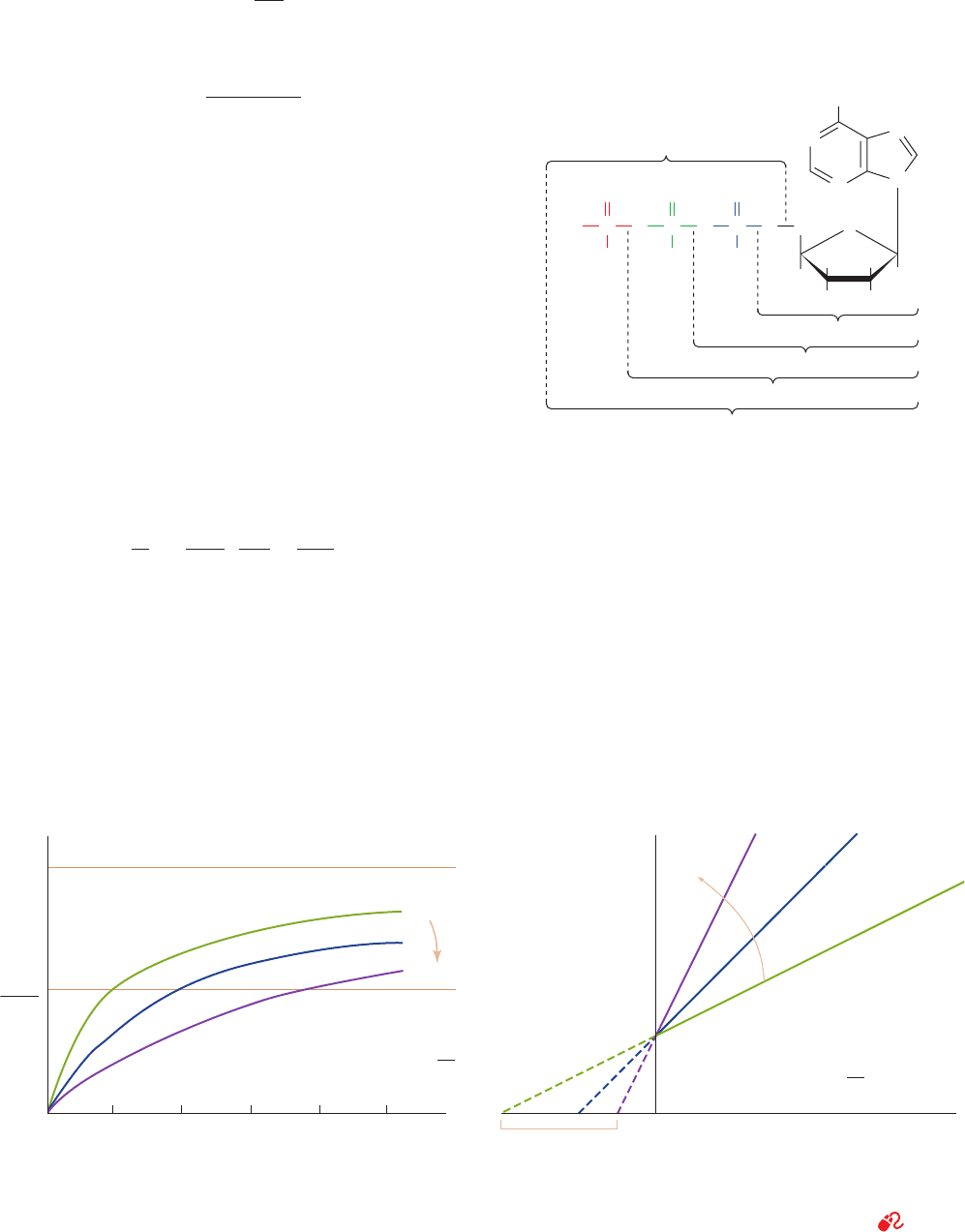
Then defining
[14.37]
and V
max
⫽ k
2
[E]
T
as in Eq. [14.23],
[14.38]
This is the Michaelis–Menten equation with K
M
modulated
by ␣, a function of the inhibitor concentration (which, ac-
cording to Eq. [14.37], must always be ⱖ1).The value of [S]
at v
o
⫽ V
max
/2 is therefore ␣K
M
.
Figure 14-11 shows the hyperbolic plot of Eq. [14.38] for
various values of ␣. Note that as [S] S ⬁, v
o
S V
max
for any
value of ␣. The larger the value of ␣, however, the greater
[S] must be to approach V
max
. Thus, the inhibitor does not
affect the turnover number of the enzyme. Rather, the
presence of I has the effect of making [S] appear more di-
lute than it actually is, or alternatively, making K
M
appear
larger than it really is. Conversely, increasing [S] shifts the
substrate-binding equilibrium toward ES. Hence, there is
true competition between I and S for the enzyme’s
substrate-binding site; their binding is mutually exclusive.
Recasting Eq. [14.38] in the double-reciprocal form
yields
[14.39]
A plot of this equation is linear and has a slope of
␣K
M
/V
max
, a 1/[S] intercept of –1/␣K
M
, and a 1/v
o
intercept
of 1/V
max
(Fig. 14-12). The double-reciprocal plots for a
competitive inhibitor at various concentrations of I intersect
at 1/V
max
on the 1/v
o
axis; this is diagnostic for competitive
inhibition as compared with other types of inhibition (Sec-
tions 14-3B and 14-3C).
1
v
o
⫽ a
␣K
M
V
max
b
1
[S]
⫹
1
V
max
v
o
⫽
V
max
[S]
aK
M
⫹ [S]
a ⫽ a1 ⫹
[I]
K
I
b
By determining the values of ␣ at different inhibitor con-
centrations, the value of K
I
can be found from Eq. [14.37].
In this way, competitive inhibitors can be used to probe
the structural nature of an active site. For example, to as-
certain the importance of the various segments of an ATP
molecule
for binding to the active site of an ATP-requiring enzyme,
one might determine the K
I
, say, for ADP,AMP (adenosine
monophosphate), ribose, triphosphate ion, etc. Since many
of these ATP components are catalytically inactive, inhibi-
tion studies are the most convenient means of monitoring
their binding to the enzyme.
If the inhibitor binds irreversibly to the enzyme, the
inhibitor is classified as an inactivator, as is any agent
that somehow inactivates the enzyme. Inactivators truly
reduce the effective level of [E]
T
at all values of [S].
Reagents that modify specific amino acid residues can
act in this manner.
O
HH
H
H
HO OH
CH
2
N
NH
2
N
N
N
Triphosphate
Ribose
AMP
ADP
ATP
O
–
P
O
O
O
O
–
P
O
O
O
–
P
O
–
O
494 Chapter 14. Rates of Enzymatic Reactions
Figure 14-11 Competitive inhibition. Plot of the initial
velocity v
o
of a simple Michaelis–Menten reaction versus the
substrate concentration [S] in the presence of different
concentrations of a competitive inhibitor.
Figure 14-12 Lineweaver–Burk plot of the competitively
inhibited Michaelis–Menten enzyme described by Fig. 14-11.
Note that all lines intersect on the 1/v
o
axis at 1/V
max
. See
the Animated Figures
Increasing
[I]
[I]
a = 1 (no inhibitor)
a = 2
a = 4
a = 1 +
K
I
v
o
V
max
V
max
2
0
K
M
2K
M
3K
M
4K
M
5K
M
[S]
Slope = a K
M
/V
max
–1/a K
M
a = 1 (no inhibitor)
1/[S]
0
[I]
a = 1 +
K
I
1/V
max
a = 2
a = 4
1/v
o
Increasing
[I]
JWCL281_c14_482-505.qxd 6/3/10 12:09 PM Page 494

B. Uncompetitive Inhibition
In uncompetitive inhibition, the inhibitor binds directly to
the enzyme–substrate complex but not to the free enzyme:
The inhibitor-binding step, which has the dissociation
constant
[14.40]
is assumed to be at equilibrium.The binding of the uncom-
petitive inhibitor, which need not resemble the substrate, is
envisioned to cause structural distortion of the active site,
thereby rendering the enzyme catalytically inactive. (If the
inhibitor binds to enzyme alone, it does so without affect-
ing its affinity for substrate.)
The Michaelis–Menten equation for uncompetitive in-
hibition, which is derived in Appendix B of this chapter, is
[14.41]
where
[14.42]
Inspection of this equation indicates that at high values of
[S], v
o
asymptotically approaches V
max
/␣¿, so that, in con-
trast to competitive inhibition, the effects of uncompetitive
inhibition on V
max
are not reversed by increasing the sub-
strate concentration. However, at low substrate concentra-
tions, that is, when [S] ⬍⬍ K
M
, the effect of an uncompeti-
tive inhibitor becomes negligible, again the opposite
behavior of a competitive inhibitor.
When cast in the double-reciprocal form, Eq. [14.41] be-
comes
[14.43]
The Lineweaver–Burk plot for uncompetitive inhibition is
linear with slope K
M
/V
max
, as in the uninhibited reaction,
and with 1/v
o
and 1/[S] intercepts of ␣¿/V
max
and ⫺␣¿/K
M
,
respectively. A series of Lineweaver–Burk plots at various
uncompetitive inhibitor concentrations consists of a family
of parallel lines (Fig. 14-13). This is diagnostic for uncom-
petitive inhibition.
Uncompetitive inhibition requires that the inhibitor
affect the catalytic function of the enzyme but not its
substrate binding. For single-substrate enzymes it is
difficult to conceive of how this could happen with the
1
v
o
⫽ a
K
M
V
max
b
1
[S]
⫹
␣¿
V
max
␣¿ ⫽ 1 ⫹
[I]
K¿
I
v
o
⫽
V
max
[S]
K
M
⫹␣¿[S]
K¿
I
⫽
[ES][I]
[ESI]
ESI
¡
NO REACTION
Δ
K¿
I
I
⫹
E ⫹ S Δ
k
1
k
⫺1
ES
¡
k
2
P ⫹ E
exception of small inhibitors such as protons (see Section
14-4) or metal ions. As we discuss in Section 14-5C, how-
ever, uncompetitive inhibition is important for multisub-
strate enzymes.
C. Mixed Inhibition
If both the enzyme and the enzyme–substrate complex
bind inhibitor, the following model results:
EI
Both of the inhibitor-binding steps are assumed to be at
equilibrium but with different dissociation constants:
[14.44]
This phenomenon is alternatively known as mixed inhibi-
tion or noncompetitive inhibition. Presumably a mixed in-
hibitor binds to enzyme sites that participate in both sub-
strate binding and catalysis.
The Michaelis–Menten equation for mixed inhibition,
which is derived in Appendix C of this chapter, is
[14.45]
where ␣ and ␣¿ are defined in Eqs. [14.37] and [14.42], re-
spectively. It can be seen from Eq. [14.45] that the name
“mixed inhibition” arises from the fact that the denomina-
tor has the factor ␣ multiplying K
M
as in competitive inhi-
bition (Eq. [14.38]) and the factor ␣¿ multiplying [S] as in
uncompetitive inhibition (Eq. [14.41]). Mixed inhibitors
v
o
⫽
V
max
[S]
aK
M
⫹ a¿[S]
K
I
⫽
[E][I]
[EI]
and
K¿
I
⫽
[ES][I]
[ESI]
ESI
¡
NO REACTION
Δ
K¿
I
Δ
K
I
II
⫹⫹
E ⫹ S Δ
k
1
k
⫺1
ES
¡
k
2
P ⫹ E
Section 14-3. Inhibition 495
Figure 14-13 Lineweaver–Burk plot of a simple
Michaelis–Menten enzyme in the presence of uncompetitive
inhibitor. Note that all lines have identical slopes of K
M
/V
max
.
See the Animated Figures
1/[S]
1/v
o
0
Slope = K
M
/V
max
a ′/V
max
–a ′/K
M
a ′= 1 (no inhibitor)
a ′ = 1.5
a ′ = 2
Increasing
[I]
[I]
a ′ = 1 +
K
′
I
JWCL281_c14_482-505.qxd 6/3/10 12:09 PM Page 495
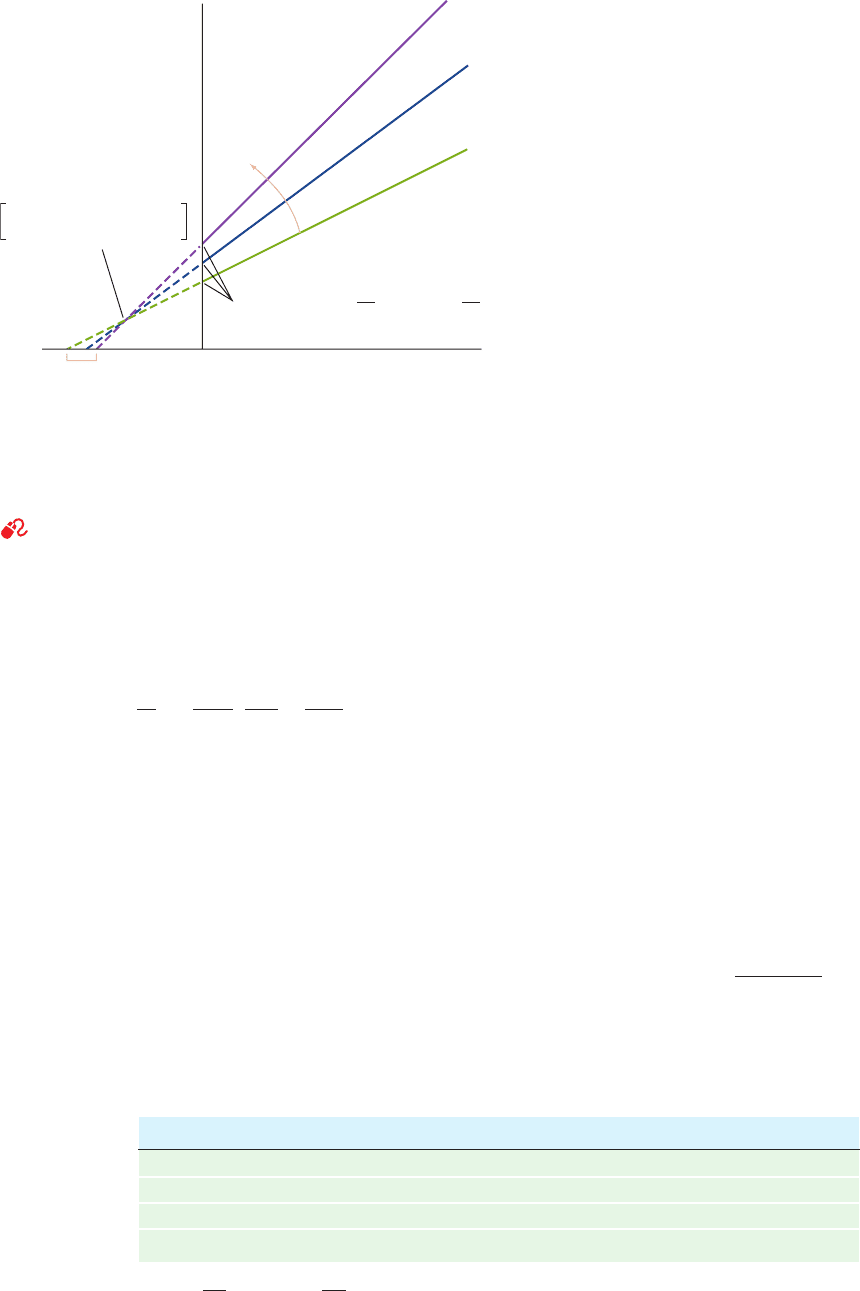
are therefore effective at both high and low substrate con-
centrations.
The Lineweaver–Burk equation for mixed inhibition is
[14.46]
The plot of this equation consists of lines that have slope
␣K
M
/V
max
with a 1/v
o
intercept of ␣¿/V
max
and a 1/[S] inter-
cept of –␣¿/␣K
M
(Fig. 14-14). Algebraic manipulation of
Eq. [14.46] for different values of [I] reveals that this equa-
tion describes a family of lines that intersect to the left of
the 1/v
o
axis (Fig. 14-14). For the special case in which
K
I
⫽ K¿
I
(␣ ⫽ ␣¿), the intersection is, in addition, on the
1/[S] axis, a situation which, in an ambiguity of nomencla-
ture, is sometimes described as noncompetitive inhibition.
Table 14-2 provides a summary of the preceding results
concerning the inhibition of simple Michaelis–Menten
1
v
o
⫽ a
aK
M
V
max
b
1
[S]
⫹
a¿
V
max
enzymes. The quantities K
M
app
and V
app
max
are the “apparent”
values of K
M
and V
max
that would actually be observed in
the presence of inhibitor for the Michaelis–Menten equa-
tion describing the inhibited enzymes.
4 EFFECTS OF pH
Enzymes, being proteins, have properties that are quite
pH sensitive. Most proteins, in fact, are active only within
a narrow pH range, typically 5 to 9. This is a result of the
effects of pH on a combination of factors: (1) the binding of
substrate to enzyme, (2) the catalytic activity of the en-
zyme, (3) the ionization of substrate, and (4) the variation
of protein structure (usually significant only at extremes
of pH).
a. pH Dependence of Simple
Michaelis–Menten Enzymes
The initial rates for many enzymatic reactions exhibit
bell-shaped curves as a function of pH (e.g., Fig. 14-15).
These curves reflect the ionizations of certain amino acid
residues that must be in a specific ionization state for en-
zyme activity.The following model can account for such pH
effects.
In this expansion of the simple one substrate–no back reac-
tion mechanism, it is assumed that only EH and ESH are
catalytically active.
The Michaelis–Menten equation for this model, which is
derived in Appendix D, is
[14.47]v
o
⫽
V¿
max
[S]
K¿
M
⫹ [S]
ESH
⫹
2
EH
⫹
2
H
⫹
Δ
K
ES1
H
⫹
Δ
K
E1
EH ⫹ S Δ
k
1
k
⫺1
ESH
¡
k
2
P ⫹ EH
H
⫹
Δ
K
ES2
H
⫹
Δ
K
E2
ES
⫺
E
⫺
496 Chapter 14. Rates of Enzymatic Reactions
Table 14-2 Effects of Inhibitors on the Parameters of the Michaelis–Menten Equation
a
a
a ⫽ 1 ⫹
[I]
K
I
and a¿ ⫽ 1 ⫹
[I]
K¿
I
.
Type of Inhibition
None V
max
K
M
Competitive V
max
␣K
M
Uncompetitive V
max
/␣¿ K
M
/␣¿
Mixed V
max
/␣¿ ␣K
M
/␣¿
K
app
M
V
app
max
Figure 14-14 Lineweaver–Burk plot of a simple
Michaelis–Menten enzyme in the presence of a mixed inhibitor.
Note that the lines all intersect to the left of the 1/v
o
axis.The
coordinates of this intersection point are given in brackets.When
K
I
⫽ K¿
I
, a ⫽ a¿ and the lines intersect on the 1/[S] axis at –1/K
M
.
See the Animated Figures
Slope = a K
M
/V
max
a ′/V
max
a = a ′ = 1
(no inhibitor)
a = 1.5
a ′ = 1.25
a = 2.0
a ′ = 1.5
1/[S]
1/v
o
0
–
a – a ′
__________
(a – 1)V
max
1 – a ′
_________
(a – 1) K
M
,
a ′
_____
a K
M
Increasing
[I]
[I]
a = 1 +
K
I
[I]
a ′ = 1 +
K
′
I
JWCL281_c14_482-505.qxd 2/19/10 2:21 PM Page 496
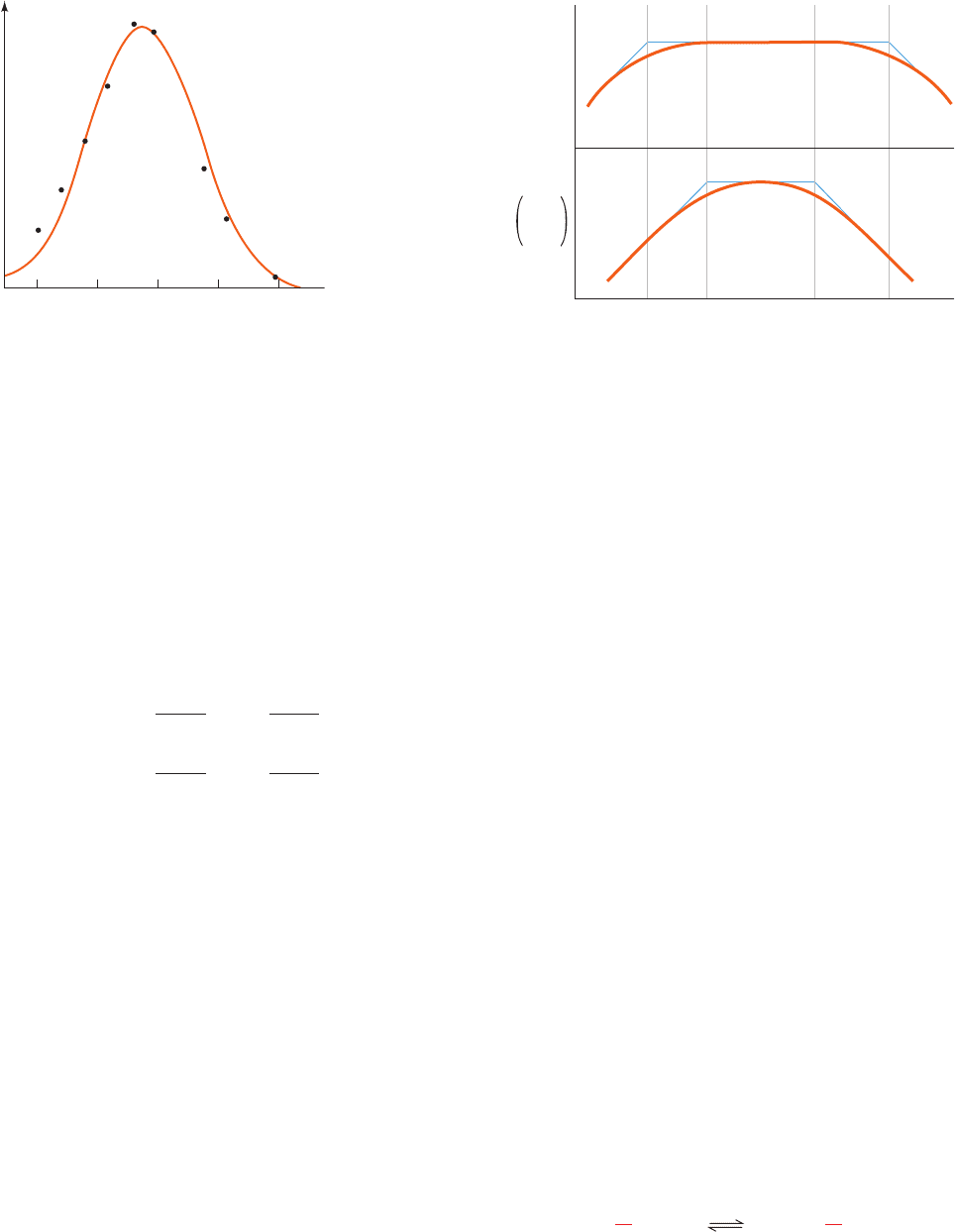
Here the apparent Michaelis–Menten parameters are
defined
where
and V
max
and K
M
refer to the active forms of the enzyme,
EH and ESH. Note that at any given pH, Eq. [14.47] be-
haves as a simple Michaelis–Menten equation, but because
of the pH dependence of ƒ
1
and ƒ
2
, v
o
varies with pH in a
bell-shaped manner (e.g., Fig. 14-15).
b. Evaluation of Ionization Constants
The ionization constants of enzymes that obey Eq.
[14.47] can be evaluated by the analysis of the curves of log
V¿
max
versus pH, which provides values of K
ES1
and K
ES2
(Fig. 14-16a), and of log(V¿
max
/K¿
M
) versus pH, which yields
K
E1
and K
E2
(Fig. 14-16b).This, of course, entails the deter-
mination of the enzyme’s Michaelis–Menten parameters at
each of a series of different pH’s.
The measured pK’s often provide valuable clues as to
the identities of the amino acid residues essential for enzy-
matic activity. For example, a measured pK of ⬃4 suggests
that an Asp or Glu residue is essential to the enzyme. Sim-
ilarly, pK’s of ⬃6 or ⬃10 suggest the participation of a His
or a Lys residue, respectively. However, a given acid–base
group may vary by as much as several pH units from its
expected value as a consequence of the electrostatic in-
fluence of nearby charged groups, as well as of the prox-
f
2
⫽
[H
⫹
]
K
ES1
⫹ 1 ⫹
K
ES2
[H
⫹
]
f
1
⫽
[H
⫹
]
K
E1
⫹ 1 ⫹
K
E2
[H
⫹
]
V¿
max
⫽ V
max
>f
2
and
K¿
M
⫽ K
M
(f
1
>f
2
)
imity of regions of low polarity. For example, the car-
boxylate group of a Glu residue forming a salt bridge
with a Lys residue is stabilized by the nearby positive
charge and therefore has a lower pK than it would other-
wise have; that is, it is more difficult to protonate. Con-
versely, a carboxylate group immersed in a region of low
polarity is less acidic than normal because it attracts pro-
tons more strongly than if it were in a region of higher
polarity. The identification of a kinetically characterized
pK with a particular amino acid residue must therefore
be verified by other types of measurements such as the
use of group-specific reagents to inactivate a putative es-
sential residue.
5 BISUBSTRATE REACTIONS
We have heretofore been concerned with reactions involv-
ing enzymes that require only a single substrate. Yet enzy-
matic reactions involving two substrates and yielding two
products
account for ⬃60% of known biochemical reactions.Almost
all of these so-called bisubstrate reactions are either trans-
ferase reactions in which the enzyme catalyzes the transfer
of a specific functional group, X, from one of the substrates
to the other:
or oxidation–reduction reactions in which reducing equiv-
alents are transferred between the two substrates. For ex-
ample, the hydrolysis of a peptide bond by trypsin (Section
7-1Da) is the transfer of the peptide carbonyl group from
PPX
X
BB++
E
A ⫹ B Δ
E
P ⫹ Q
Section 14-5. Bisubstrate Reactions 497
Figure 14-16 The pH dependence of (a) log V¿
max
and (b) log
(V⬘
max
/K⬘
M
). The light blue lines indicate how the values of the
molecular ionization constants can be determined by graphical
extrapolation.
Figure 14-15 Effect of pH on the initial rate of the reaction
catalyzed by the enzyme fumarase. [After Tanford, C., Physical
Chemistry of Macromolecules, p. 647, Wiley (1961).]
5
0
6789
pH
v
o
(a)
(b)
pH
V
′
max_____
K
′
M
log V
′
max
log
pK
ES1
pK
ES2
pK
E1
pK
E2
JWCL281_c14_482-505.qxd 2/19/10 2:21 PM Page 497
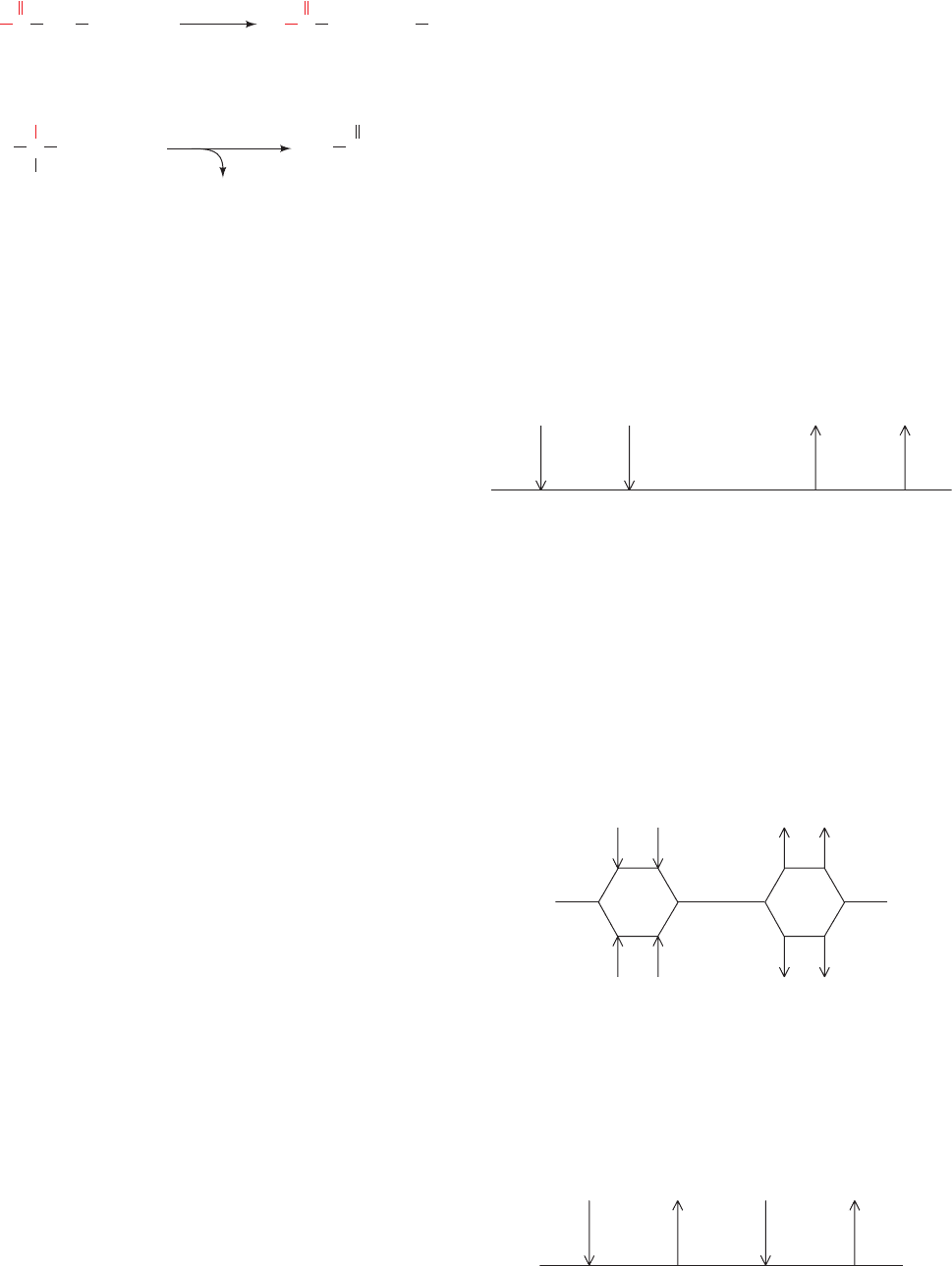
the peptide nitrogen atom to water (Fig. 14-17a). Similarly,
in the alcohol dehydrogenase reaction (Section 13-2A), a
hydride ion is formally transferred from ethanol to NAD
⫹
(Fig. 14-17b). Although such bisubstrate reactions could, in
principle, occur through a vast variety of mechanisms, only
a few types are commonly observed.
A. Terminology
We shall follow the nomenclature system introduced by
W.W. Cleland for representing enzymatic reactions:
1. Substrates are designated by the letters A, B, C, and
D in the order that they add to the enzyme.
2. Products are designated P, Q, R, and S in the order
that they leave the enzyme.
3. Stable enzyme forms are designated E, F, and G with
E being the free enzyme, if such distinctions can be made.
A stable enzyme form is defined as one that by itself is in-
capable of converting to another stable enzyme form (see
below).
4. The numbers of reactants and products in a given re-
action are specified, in order, by the terms Uni (one), Bi
(two), Ter (three), and Quad (four). A reaction requiring
one substrate and yielding three products is designated a
Uni Ter reaction. In this section, we shall be concerned
with reactions that require two substrates and yield two
products, that is, Bi Bi reactions. Keep in mind, however,
that there are numerous examples of even more complex
reactions.
a. Types of Bi Bi Reactions
Enzyme-catalyzed group-transfer reactions fall under
two major mechanistic classifications:
1. Sequential Reactions: Reactions in which all sub-
strates must combine with the enzyme before a reaction can
occur and products can be released are known as Sequen-
tial reactions. In such reactions, the group being trans-
ferred, X, is directly passed from A (⫽ P¬X) to B, yielding
P and Q (⫽ B¬X). Hence, such reactions are also called
single-displacement reactions.
Sequential reactions can be subclassified into those with
a compulsory order of substrate addition to the enzyme,
which are said to have an Ordered mechanism, and those
with no preference for the order of substrate addition,
which are described as having a Random mechanism. In the
Ordered mechanism, the binding of the first substrate is ap-
parently required for the enzyme to form the binding site
for the second substrate, whereas for the Random mecha-
nism, both binding sites are present on the free enzyme.
Let us describe enzymatic reactions using Cleland’s
shorthand notation. The enzyme is represented by a hori-
zontal line and successive additions of substrates and re-
lease of products are denoted by vertical arrows. Enzyme
forms are placed under the line and rate constants, if given,
are to the left of the arrow or on top of the line for forward
reactions. An Ordered Bi Bi reaction is represented:
where A and B are said to be the leading and following
substrates, respectively. Here, only minimal details are
given concerning the interconversions of intermediate en-
zyme forms because, as we have seen for reversible single-
substrate enzymes, steady-state kinetic measurements
provide no information concerning the number of inter-
mediates in a given reaction step. Many NAD
⫹
- and
NADP
⫹
-requiring dehydrogenases follow an Ordered Bi
Bi mechanism in which the coenzyme is the leading
reactant.
A Random Bi Bi reaction is diagrammed:
Some dehydrogenases and kinases operate through
Random Bi Bi mechanisms.
2. Ping Pong Reactions: Mechanisms in which one or
more products are released before all substrates have been
added are known as Ping Pong reactions. The Ping Pong
Bi Bi reaction is represented by
E
APBQ
EEA–FP F FB–EQ
A B
BA
EA
EB
P
Q
QP
EQ
EP
E EAB–EPQ
E
E
AB PQ
EEA EAB k
_
3
k
3
k
1
k
_
1
k
2
k
_
2
k
4
k
_
4
k
5
k
_
5
EPQ EQ
498 Chapter 14. Rates of Enzymatic Reactions
Figure 14-17 Some bisubstrate reactions. (a) In the peptide
hydrolysis reaction catalyzed by trypsin, the peptide carbonyl
group, with its pendent polypeptide chain, is transferred from the
peptide nitrogen atom to a water molecule. (b) In the alcohol
dehydrogenase reaction, a hydride ion is formally transferred
from ethanol to NAD
⫹
.
(a)
(b)
NHC
O
R
1
H
3
N
H
2
O
R
2
+
trypsin
+
R
2
+O
–
C
O
R
1
Polypeptide
alcohol
dehydrogenase
+
C
H
CH
3
OH
O
CH
3
H
+ NAD
+
NADH
H
+
CH
JWCL281_c14_482-505.qxd 2/19/10 2:21 PM Page 498

In it, a functional group X of the first substrate A (⫽ P¬X)
is displaced from the substrate by the enzyme E to yield the
first product P and a stable enzyme form F (⫽ E¬X) in
which X is tightly (often covalently) bound to the enzyme
(Ping). In the second stage of the reaction, X is displaced
from the enzyme by the second substrate B to yield the sec-
ond product Q (⫽ B¬X), thereby regenerating the origi-
nal form of the enzyme, E (Pong). Such reactions are there-
fore also known as double-displacement reactions. Note
that in Ping Pong Bi Bi reactions, the substrates A and B do
not encounter one another on the surface of the enzyme.
Many enzymes, including chymotrypsin (Section 15-3),
transaminases (Section 26-1A), and some flavoenzymes,
react with Ping Pong mechanisms.
B. Rate Equations
Steady-state kinetic measurements can be used to distin-
guish among the foregoing bisubstrate mechanisms. In or-
der to do so, one must first derive their rate equations. This
can be done in much the same manner as for single-
substrate enzymes, that is, solving a set of simultaneous lin-
ear equations consisting of an equation expressing the
steady-state condition for each kinetically distinct enzyme
complex plus one equation representing the conservation
condition for the enzyme. This, of course, is a more complex
undertaking for bisubstrate enzymes than it is for single-
substrate enzymes.
The rate equations for the above described bisubstrate
mechanisms in the absence of products are given below in
double-reciprocal form.
a. Ordered Bi Bi
[14.48]
b. Rapid Equilibrium Random Bi Bi
The rate equation for the general Random Bi Bi reaction
is quite complicated. However, in the special case that both
substrates are in rapid and independent equilibrium with
the enzyme, that is, when the EAB–EPQ interconversion is
rate determining, the initial rate equation reduces to the
1
v
o
⫽
1
V
max
⫹
K
A
M
V
max
[A]
⫹
K
B
M
V
max
[B]
⫹
K
A
S
K
B
M
V
max
[A][B]
following relatively simple form. This mechanism is known
as the Rapid Equilibrium Random Bi Bi mechanism:
[14.49]
c. Ping Pong Bi Bi
[14.50]
d. Physical Significance of the Bisubstrate
Kinetic Parameters
The kinetic parameters in the equations describing
bisubstrate reactions have meanings similar to those for
single-substrate reactions. V
max
is the maximal velocity of
the enzyme obtained when both A and B are present at sat-
urating concentrations, and are the respective con-
centrations of A and B necessary to achieve in the
presence of a saturating concentration of the other, and
and are the respective dissociation constants of A and B
from the enzyme, E.
C. Differentiating Bisubstrate Mechanisms
One can discriminate between Ping Pong and Sequential
mechanisms from their contrasting properties in linear
plots such as those of the Lineweaver–Burk type.
a. Diagnostic Plot for Ping Pong Bi Bi Reactions
A plot of 1/v
o
versus 1/[A] at constant [B] for Eq. [14.50]
yields a straight line of slope K
A
M
/V
max
and an intercept on
the 1/v
o
axis equal to the last two terms in Eq. [14.50]. Since
the slope is independent of [B], such plots for different val-
ues of [B] yield a family of parallel lines (Fig. 14-18).A plot
of 1/v
o
versus 1/[B] for different values of [A] likewise
yields a family of parallel lines. Such parallel lines are diag-
nostic for a Ping Pong mechanism.
b. Diagnostic Plot for Sequential Bi Bi Reactions
The equations representing the Ordered Bi Bi mecha-
nism (Eq. [14.48]) and the Rapid Equilibrium Random Bi
K
B
S
K
A
S
1
2
V
max
K
B
M
K
A
M
1
v
o
⫽
K
A
M
V
max
[A]
⫹
K
B
M
V
max
[B]
⫹
1
V
max
1
v
o
⫽
1
V
max
⫹
K
A
S
K
B
M
V
max
K
B
S
[A]
⫹
K
B
M
V
max
[B]
⫹
K
A
S
K
B
M
V
max
[A] [B]
Section 14-5. Bisubstrate Reactions 499
Figure 14-18 Double-reciprocal plots for an enzymatic
reaction with a Ping Pong Bi Bi mechanism. (a) Plots of 1/v
o
Increasing
constant [B]
1/v
o
001/[A] 1/[B]
(a) (b)
1/v
o
Increasing
constant [A]
Slope = K
M
A
/V
max
Slope = K
M
B
/V
max
Intercept = +
1
V
max
K
M
B
V
max
[B]
Intercept = +
1
V
max
K
M
A
V
max
[A]
versus 1/[A] at various constant concentrations of B. (b) Plots of
1/v
o
versus 1/[B] at various constant concentrations of A.
JWCL281_c14_482-505.qxd 6/3/10 12:09 PM Page 499

Bi mechanism (Eq. [14.49]) have identical functional de-
pendence on [A] and [B].
Equation [14.48] can be rearranged to
[14.51]
Thus plotting 1/v
o
versus 1/[A] for constant [B] yields a lin-
ear plot with a slope equal to the coefficient of 1/[A] and an
intercept on the 1/v
o
axis equal to the second term of Eq.
[14.51] (Fig. 14-19a). Alternatively, Eq. [14.48] can be re-
arranged to
[14.52]
which yields a linear plot of 1/v
o
versus 1/[B] for constant
[A] with a slope equal to the coefficient of 1/[B] and an in-
tercept on the 1/v
o
axis equal to the second term of Eq.
[14.52] (Fig. 14-19b). The characteristic feature of these
plots, which is indicative of a Sequential mechanism, is that
the lines intersect to the left of the 1/v
o
axis.
c. Differentiating Random and Ordered
Sequential Mechanisms
The Ordered Bi Bi mechanism may be experimentally
distinguished from the Random Bi Bi mechanism through
product inhibition studies. If only one product of the reac-
tion, P or Q, is added to the reaction mixture, the reverse
reaction still cannot occur. Nevertheless, by binding to the
enzyme, this product will inhibit the forward reaction. For
1
v
o
⫽
K
B
M
V
max
a1 ⫹
K
A
S
[A]
b
1
[B]
⫹
1
V
max
a1 ⫹
K
A
M
[A]
b
1
v
o
⫽
K
A
M
V
max
a1 ⫹
K
A
S
K
B
M
K
A
M
[B]
b
1
[A]
⫹
1
V
max
a1⫹
K
B
M
[B]
b
an Ordered Bi Bi reaction, Q (⫽ B¬X, the second product
to be released) directly competes with A (⫽ P¬X, the
leading substrate) for binding to E and hence is a competi-
tive inhibitor of A when [B] is fixed (the presence of X in
Q ⫽ B¬X interferes with the binding of A ⫽ P¬X). How-
ever, since B combines with EA, not E, Q is a mixed in-
hibitor of B when [A] is fixed (Q interferes with both the
binding of B to enzyme and with the catalysis of the reac-
tion). Similarly, P, which combines only with EQ, is a mixed
inhibitor of A when [B] is held constant and of B when [A]
is held constant. In contrast, in a Rapid Equilibrium Bi Bi
reaction, since both products as well as both substrates can
combine directly with E, both P and Q are competitive in-
hibitors of A when [B] is constant and of B when [A] is
constant. These product inhibition patterns are summa-
rized in Table 14-3.
D. Isotope Exchange
Mechanistic conclusions based on kinetic analyses alone
are fraught with uncertainties and are easily confounded
by inaccurate experimental data. A particular mechanism
for an enzyme is therefore greatly corroborated if the
mechanism can be shown to conform to experimental cri-
teria other than kinetic analysis.
Sequential (single-displacement) and Ping Pong (double-
displacement) bisubstrate mechanisms may be differentiated
through the use of isotope exchange studies. Double-
displacement reactions are capable of exchanging an iso-
tope from the first product P back to the first substrate A in
500 Chapter 14. Rates of Enzymatic Reactions
Table 14-3 Patterns of Product Inhibition for Sequential Bisubstrate Mechanisms
Mechanism Product Inhibitor [A] Variable [B] Variable
Ordered Bi Bi P Mixed Mixed
Q Competitive Mixed
Rapid Equilibrium Random Bi Bi P Competitive Competitive
Q Competitive Competitive
Figure 14-19 Double-reciprocal plots of an enzymatic reaction
with a Sequential Bi Bi mechanism. (a) Plots of 1/v
o
versus 1/[A]
at various constant concentrations of B. (b) Plots of 1/v
o
versus
1/[B] at various constant concentrations of A.The corresponding
Increasing
constant [B]
1/v
o
001/[A] 1/[B]
(a) (b)
1/v
o
Increasing
constant [A]
K
S
A
V
max
Slope =
K
M
A
+
K
M
B
[B]
K
S
A
V
max
Slope =
K
M
B
+
K
M
B
[A]
Intercept =
1 + K
M
B
/[B]
V
max
Intercept =
K
M
A
/[A]1 +
V
max
–1/K
M
A
K
M
A
K
S
A
K
M
B
–
plots for Rapid Equilibrium Random Bi Bi reactions have
identical appearances; their lines all intersect to the left of the
1/v
o
axis.
JWCL281_c14_482-505.qxd 2/19/10 2:21 PM Page 500
